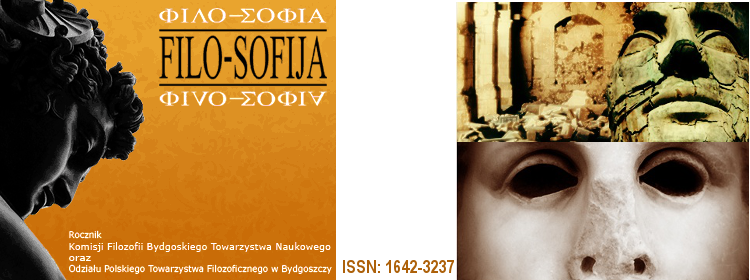Z drogi twórcy. Ku metafizyce źródła
Abstract
In the essay, the author undertakes considerations on questions and problems connected with: the creator and creation, the pathway of the creator and the coign of vantage adopted. The author shows the pivotal features of this existential philosophical concept of the creator’s pathway. The essay is given by the author a motto – a poem by Cyprian Kamil Norwid entitled Narcyz (Narcissus). Addressing the poem, the author considers the signification of the vibrating silhouette of Narcyz (Narcissus) when mirrored (reflected) in water. In the vibrating, a special pulsating of the sources of creation is recognizable. The vibrating is, according to the author, the appearance of the creator’s being-towards-the- creative-source departing from the mere sources of creation. The vibrating silhouette of Narcyz (Narcissus), in turn, makes for the recognition of the specifics of the creator’s being-on-the-pathway. The main motive of the considerations is the character of the sources connected with creating, i.e., them being two-fold and to be distinguished as the sources of creation and the creative sources. Two metaphorical images are adduced in this context: that of “The Child and the Source” and that of “The Child and the Mirror”. The sources that pulsate in the wood and on the meadows are compared by the author to the sources of creation. On the contrary, the hardly accessible sources of brooks and rivers, hidden in the high hills and in the mountains represent the creative sources. The creator’s pathway leads from the former to the latter. According to the author, the important role on the creative pathway is played by vison (the creator’s being a visionary) as a factor that directs the pathway of the creator. Vision is a link and meditates between the sources of creation and the creative source. The symbolic and reflective compliment of the vision is mission – a link joining the vision and the objective of the creator. Mission accompanies the vision and – as the author claims – somehow emerges from it. It represents the objective of the creator referring to the divine. The author – both a poet and philosopher – uses the typical Socratic metaphor of the essence of philosophizing understood as the art of midwifery – téchne maieutiké (τέχνη μαιευτική). A midwife delivers a baby; a poet delivers, as it were, himself and this because of – as the author asserts – understanding and pursuing the creative process. Other thinkers quoted in this context by M.K. Siwiec with the predilection are Arthur Schopenhauer and Friedrich Nietzsche. The author points out that in Schopenhauer the pathway of the creator is connected with the problem of the esthetic contemplation, genius, the work of art, beauty and loftiness. Schopenhauer uses the symbol of the sunlight to describe the cognitive abilities of a genius and to characterize his pathway, which could be thus called that of a creator. The opposite of it was the symbol of lighthouse and the pathway of ordinary men. Contrary to them, treading as cautiously as to protect themselves, a genius undertakes the risk of entering the world displayed before his eyes. The world shows numerous possibilities possibly used by a creator when accomplishing his work. In Nietzsche, as the author claims, not only the creative process and the works of art do appear on the pathway of the creator, but something more in addition, viz. the regeneration of the creator or self-burning and rising from ashes. The creator’s pathway, since leading from the sources of creation and the creative sources, joins them both. M.K. Siwiec asks the following question: “What is, then, that reflected beaming of the creative source and encompassing the sources of creation?” and refers to Plato. In the symbol of the man carrying a mirror, the fact that the mirror is just carried about is pointed out. The mirror is directed first to the sun and to the sky, next, to the earth, then, to who carries it and the other living creatures, and eventually, to utensils and plants as well as other things. The author draws attention to those particular reflections of the light beams, thrown, as it were, into the creator’s eyes by the creative source. For, art is a mirror that reflects the light or luster of the creative source.
Pełny tekst:
PDFAdministracja Cytowania | Strony czasopism
